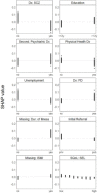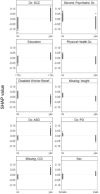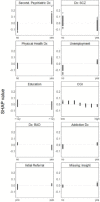Contribution of socio-demographic and clinical characteristics to predict initial referrals to psychosocial interventions in patients with serious mental illness
- PMID: 38282331
- PMCID: PMC10894705
- DOI: 10.1017/S2045796024000015
Contribution of socio-demographic and clinical characteristics to predict initial referrals to psychosocial interventions in patients with serious mental illness
Abstract
Aims: Psychosocial rehabilitation (PSR) is at the core of psychiatric recovery. There is a paucity of evidence regarding how the needs and characteristics of patients guide clinical decisions to refer to PSR interventions. Here, we used explainable machine learning methods to determine how socio-demographic and clinical characteristics contribute to initial referrals to PSR interventions in patients with serious mental illness.
Methods: Data were extracted from the French network of rehabilitation centres, REHABase, collected between years 2016 and 2022 and analysed between February and September 2022. Participants presented with serious mental illnesses, including schizophrenia spectrum disorders, bipolar disorders, autism spectrum disorders, depressive disorders, anxiety disorders and personality disorders. Information from 37 socio-demographic and clinical variables was extracted at baseline and used as potential predictors. Several machine learning models were tested to predict initial referrals to four PSR interventions: cognitive behavioural therapy (CBT), cognitive remediation (CR), psychoeducation (PE) and vocational training (VT). Explanatory power of predictors was determined using the artificial intelligence-based SHAP (SHapley Additive exPlanations) method from the best performing algorithm.
Results: Data from a total of 1146 patients were included (mean age, 33.2 years [range, 16-72 years]; 366 [39.2%] women). A random forest algorithm demonstrated the best predictive performance, with a moderate or average predictive accuracy [micro-averaged area under the receiver operating curve from 'external' cross-validation: 0.672]. SHAP dependence plots demonstrated insightful associations between socio-demographic and clinical predictors and referrals to PSR programmes. For instance, patients with psychotic disorders were more likely to be referred to PE and CR, while those with non-psychotic disorders were more likely to be referred to CBT and VT. Likewise, patients with social dysfunctions and lack of educational attainment were more likely to be referred to CR and VT, while those with better functioning and education were more likely to be referred to CBT and PE.
Conclusions: A combination of socio-demographic and clinical features was not sufficient to accurately predict initial referrals to four PSR programmes among a French network of rehabilitation centres. Referrals to PSR interventions may also involve service- and clinician-level factors. Considering socio-demographic and clinical predictors revealed disparities in referrals with respect to diagnoses, current clinical and psychological issues, functioning and education.
Keywords: clinical features; psychosocial rehabilitation; referrals; socio-demographic features.
Conflict of interest statement
The authors declare no competing interests.
Figures




Similar articles
-
Satisfaction and Needs in Serious Mental Illness and Autism Spectrum Disorder: The REHABase Psychosocial Rehabilitation Project.Psychiatr Serv. 2019 Apr 1;70(4):316-323. doi: 10.1176/appi.ps.201800420. Epub 2019 Jan 29. Psychiatr Serv. 2019. PMID: 30691384
-
Clinical and cognitive factors affecting psychosocial functioning in remitted patients with bipolar disorder.Psychiatriki. 2016 Jul-Sep;27(3):182-191. doi: 10.22365/jpsych.2016.273.182. Psychiatriki. 2016. PMID: 27837572
-
Systematic reviews of the effectiveness of day care for people with severe mental disorders: (1) acute day hospital versus admission; (2) vocational rehabilitation; (3) day hospital versus outpatient care.Health Technol Assess. 2001;5(21):1-75. doi: 10.3310/hta5210. Health Technol Assess. 2001. PMID: 11532238 Review.
-
[What support of young presenting a first psychotic episode, when schooling is being challenged?].Encephale. 2017 Dec;43(6):570-576. doi: 10.1016/j.encep.2017.10.001. Epub 2017 Nov 8. Encephale. 2017. PMID: 29128195 Review. French.
-
Royal Australian and New Zealand College of Psychiatrists clinical practice guidelines for the treatment of schizophrenia and related disorders.Aust N Z J Psychiatry. 2005 Jan-Feb;39(1-2):1-30. doi: 10.1080/j.1440-1614.2005.01516.x. Aust N Z J Psychiatry. 2005. PMID: 15660702 Review.
References
-
- Akshaya A, Gopal S, Pavithra R and Raghavan V (2022) Academic difficulties among young persons with mental disorders. Indian Journal of Social Psychiatry 38, 52.
-
- American Psychiatric Association (2013) Diagnostic and Statistical Manual of Mental Disorders, 5th edn. Washington, D.C: American Psychiatric Publishing.
-
- Berkelmans GFN, Read SH, Gudbjörnsdottir S, Wild SH, Franzen S, van der Graaf Y, Eliasson B, Visseren FLJ, Paynter NP and Dorresteijn JAN (2022) Population median imputation was noninferior to complex approaches for imputing missing values in cardiovascular prediction models in clinical practice. Journal of Clinical Epidemiology 145, 70–80. - PubMed
MeSH terms
LinkOut - more resources
Full Text Sources
Medical

